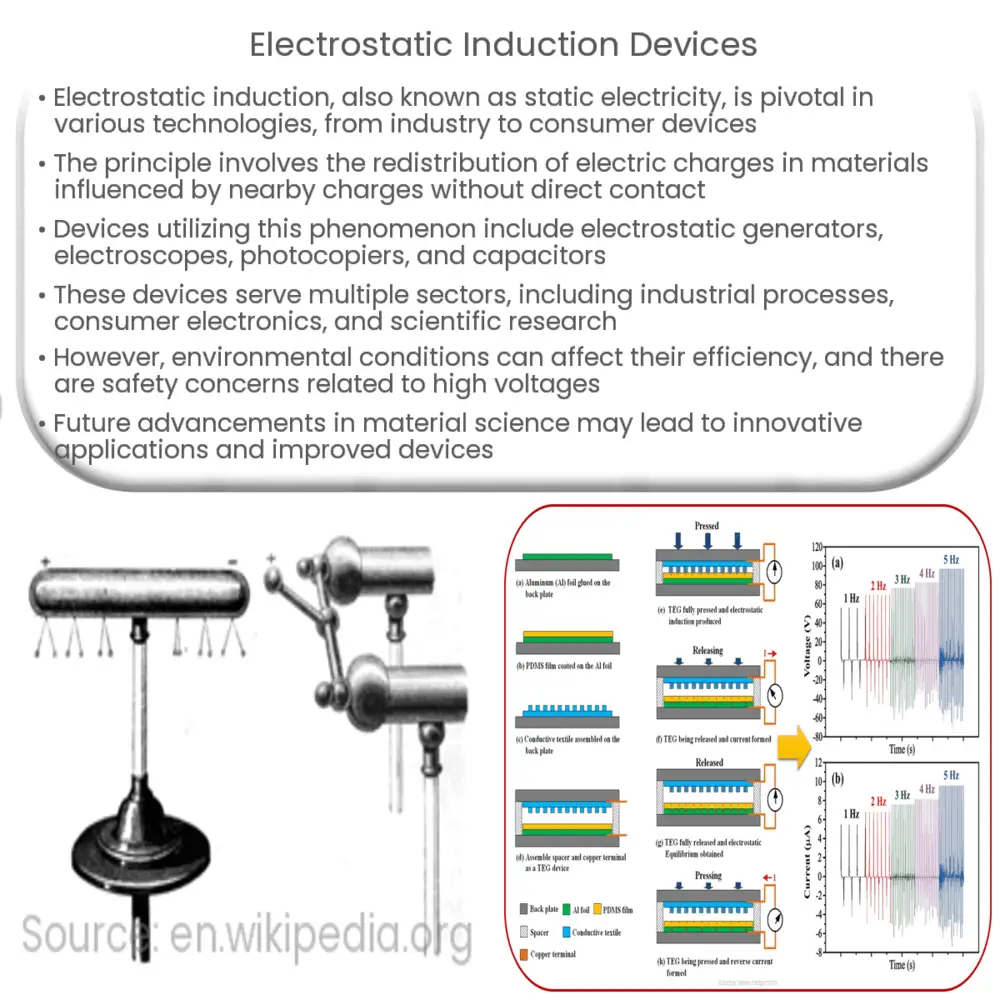Explore the fascinating world of Electrostatic Induction Devices, their principle, applications, challenges, and future prospects in this comprehensive article.

Introduction to Electrostatic Induction Devices
Electrostatic induction, also known as ‘static electricity’ or ‘triboelectricity’, plays an essential role in a range of technologies that may not be immediately evident. Devices that exploit the phenomenon of electrostatic induction find applications in various fields, from industry to everyday consumer technology.
Understanding Electrostatic Induction
At its core, electrostatic induction refers to the re-distribution of electric charges in a material, caused by the influence of nearby charges. In simpler terms, an object near a charged body will have its charges rearranged without direct contact.
Electrostatic Induction Devices: An Overview
Devices that use electrostatic induction have been around for centuries. These include early scientific instruments, like the electroscope and the electrostatic generator, but the principle is also used in more modern technology.
- Electrostatic Generators: Devices such as the Van de Graaff generator and Wimshurst machine use electrostatic induction to accumulate high voltages, often used for scientific experiments.
- Electroscopes: Instruments like the gold-leaf electroscope can detect and roughly measure electric charge, based on the principle of electrostatic induction.
- Photocopiers and Laser Printers: Modern devices like copiers and printers use electrostatic induction to transfer toner to paper.
- Capacitors: Essential components in electronic circuits, capacitors store energy via electrostatic induction.
Applications of Electrostatic Induction Devices
Electrostatic induction devices find wide-ranging applications in different sectors.
- Industrial Applications: Electrostatic induction is used in industries for tasks like electrostatic spraying, where it assists in the even distribution of particles on a surface.
- Consumer Electronics: Everyday devices like televisions, monitors, and some touch screens utilize electrostatic induction to function effectively.
- Scientific Research: Electrostatic induction plays a pivotal role in advanced research equipment, such as particle accelerators, where it is used to generate high voltages.
In summary, the phenomenon of electrostatic induction is not just an interesting physical concept, but a practical tool used extensively in various devices. These applications stretch across multiple sectors, including industrial processes, consumer electronics, and scientific research.
The Principle Behind Electrostatic Induction Devices
Electrostatic induction is a physical phenomenon based on the concept that the electric field of a charged body can influence the distribution of electric charges in a nearby conductor. This influence occurs without any physical contact between the two objects, which is a fundamental characteristic of electrostatic induction.
When a charged object is brought close to a neutral object, the latter experiences a shift of charges due to the electric field of the charged body. The closer end to the charged object becomes oppositely charged, while the far end becomes similarly charged. This rearrangement of charges forms the basis of operation for many electrostatic induction devices.
Challenges and Limitations
Despite the broad utility of electrostatic induction devices, there are challenges and limitations. The efficiency of electrostatic induction is dependent on the environmental conditions, such as humidity and temperature, which can affect the buildup and movement of charge. Moreover, safety concerns related to the handling of devices with high voltages need to be considered. For example, electrostatic discharge can potentially cause damage to sensitive electronics or even pose a risk to human operators.
Future of Electrostatic Induction Devices
Given the critical role of electrostatic induction in various technologies, there is considerable interest in enhancing its applications. Researchers are exploring ways to make these devices more efficient and safe. The trend is towards the development of compact and high-performance electrostatic devices that can operate under a wider range of conditions.
Furthermore, advances in material science are likely to bring about innovative applications of electrostatic induction. For instance, the exploration of new dielectric materials could significantly improve the energy storage capacity of capacitors, which are pivotal in electronics.
Conclusion
In conclusion, electrostatic induction is a fundamental physical phenomenon that has been harnessed in a multitude of devices across diverse fields. Despite some challenges, the utility and relevance of these devices continue to grow with technological advancement. The future is poised to see more sophisticated applications of electrostatic induction as researchers make strides in understanding this phenomenon better and incorporating it into innovative devices and applications.

